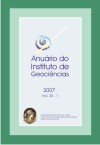Benthic foraminifera analysis in two cores from the northeastern area of Guanabara Bay
DOI:
https://doi.org/10.11137/2007_1_27-29Abstract
Guanabara bay receives a large amount of industrial and domestic sewage, which contributes for its environmental degradation. For monitoring those environmental changes, two cores from the northeastern area of the bay were analized. They were subsampled in centimeter intervals and the laboratory treatment followed specific methodology for foraminifera. Foraminifera are much sensitive microorganisms as to environmental changes as to anthropogenic ones, thus they are useful as pollution indicators. The results show low values of diversity, however, a higher diversity in the core T15, between Paquetá island and São Gonçalo than in the core T14, at São Gonçalo south region. Both of them presented Ammonia tepida as a dominant species human pollution bioindicator, and Buliminella elegatissima as bioindicator of high levels of organic matter.Downloads
Download data is not yet available.
Downloads
Published
2007-01-01
How to Cite
Fonseca, R. B. M. da (2007) “Benthic foraminifera analysis in two cores from the northeastern area of Guanabara Bay”, Anuário do Instituto de Geociências. Rio de Janeiro, BR, 30(1), pp. 27–29. doi: 10.11137/2007_1_27-29.
Issue
Section
Article
License
This journal is licensed under a Creative Commons — Attribution 4.0 International — CC BY 4.0, which permits use, distribution and reproduction in any medium, provided the original work is properly cited.















